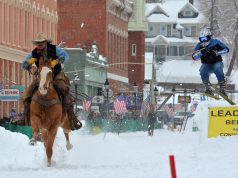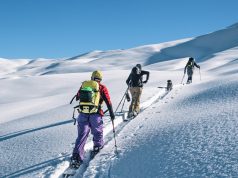Your grandma climbed one last weekend, and unless you’ve been living under a rock, you’ve probably noticed that 14ers are kind of a big thing in Colorado.
Colorado boasts 54 independent peaks above 14,000 feet of elevation. That’s more than half of all 14,000-foot peaks in the country. Trails rate in difficulty from class one (relatively easy hiking) all the way up to class five (experienced climbers wanted).
If you’re not a dedicated hiker, climber or skier, the odds are you’ve never been above 14,000 feet outside an airplane. Daunting though it may seem, just about anyone can make it to the top with a little preparation, a free day and a touch of determination.
What to expect when you’re ascending
Colorado’s obsession with the outdoors means there are plenty of places to get information. Guidebooks and websites offer advice on every 14er in the state, complete with pictures, personal stories, videos and fascinating trivia.
The two most popular guidebooks to fourteeners are Gerry Roach’s Colorado Fourteeners: From Hikes to Climbs and the classic two-volume set of Dawson’s Guide to Colorado Fourteeners. Both offer locations of trailheads, multiple routes, difficulty ratings and general advice. Dawson’s Guide, by Louis Dawson III, also offers information on skiing down these behemoths, a feat many backcountry enthusiasts pursue. General guides to hiking and climbing in Colorado often offer more limited information on select 14ers.
The website www.14ers.com provides much of the same information, along with trip reports of recent climbs, descriptions of current snow conditions and discussions with experienced hikers and climbers. Videos from other hikers can also be helpful in knowing what to expect.
Blow your mind, not your afternoon
Weather in Colorado can change at a moment’s notice, and nowhere is that more true than the high altitudes of the mountains. At www.14ers.com, hikers can find the latest weather information from the National Weather Service and NOAA.
Even in the summer, hikers can experience snow, wind and cold. Packing a variety of layers that you can add or remove will make the trip much more comfortable. While companies like Go-Lite and Patagonia offer some great options, your closet probably already contains everything you need for your first 14er. If you plan on summiting more than one, investing in half-zip pants, base layers and light, portable clothing is a smart decision.
And if you see storm clouds rolling in, don’t be afraid to turn around and try again another day.
Rise and shine
Above 13,000 feet, even the most experienced Boulderite will note the thin air and bright sun, so make sure you pack plenty of water, snacks, sunscreen and protection for your eyes and head.
If you’re not sure if you can handle summiting a 14er, try some of the more challenging local hikes, like Bear Peak near NCAR, which offers nearly 3,000 feet of elevation gain, topping out at 8,461 feet over a hike that is seven miles round-trip.
Despite the worries you might have, the hardest part of climbing a 14er is waking up early. Experienced hikers recommend summiting well before noon, and with most 14ers needing at least three hours to reach the peak, that means being at the trailhead before the time you’d normally be drinking your coffee.
With these things in mind, you should be ready to tackle a 14er with ease. Perhaps next weekend, your grandma will let you keep her company, assuming you aren’t slowing her down.
Respond: [email protected]














